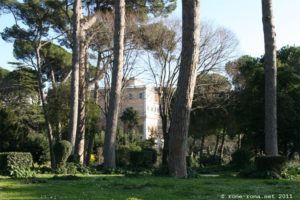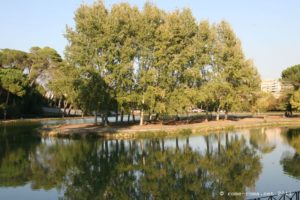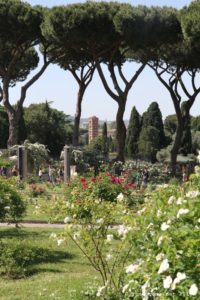Several beautiful parks and gardens are found in Rome, often associated with prestigious villas and pieces of water, sometimes with archaeological sites.
The most beautiful parks and gardens:
Villa Borghese
To the north of the historic centre, just outside the Aurellien Walls, lies the vast Villa Borghese, the most popular public park in Rome. It is largely landscaped, with spaces adorned with statues, fountains, century-old trees, works by artists of baroque or neoclassical art, and small lakes where to take a boat ride. there is the Borghese Gallery, in the homonymous palace of Villa Borghese, a zoo Bioparco, or the Casa del Cinema with the terrace of its Cinecaffé.
Pincio promenade
The park of the Pincian hill is next to the nearby Villa Borghese Park. It overlooks Piazza del Popolo and overlooks the Campo Marzio from its panoramic terrace. It is one of the most charming green spaces in the city, appreciated by the Romans for the Sunday walk. This elegant little park, named Pincio promenade (Passeggiata del Pincio) in Italian, extends over eight hectares, with pretty monuments, statues and fountains.
Villa Doria-Pamphilj
A little outside the center of Rome, on the Trastevere side, Villa Doria-Pamphilj is the largest park in Rome with 180 hectares, cut in half by a large avenue, which a footbridge allows to cross. It is dominated by pine trees and two bodies of water.
It is a beautiful place to relax or play sports, with more or less wooded grassy areas, a pine forest, artistic fountains, or playgrounds, etc. The elegant palace of Villa Pamphilj is accompanied by beautiful gardens.
Park of the Appian Way
The Park of the Appian Way (Parco dell’Appia Antica) is a special and fascinating place in Rome. Along the ancient Appian Way from the Porta San Sebastiano gate, it extends over 3,500 hectares with neighboring parks, with fields, farms, important archaeological sites including Roman villas, or the many tombs along the first paved road by the Romans, without forgetting the Christian catacombs. Goats are regularly seen there, and it includes other parks, including the adjoining Park of the Caffarella semi-wild with its sheep, or the Park of the Aqueducts.
Villa Celimontana
Between the Colosseum and the Baths of Caracalla, Villa Celimontana is a green oasis and former public park, located on the Caelius hill. The main palace dates from the 16th century, and there are some archaeological remains, an Egyptian obelisk, a neo-Gothic temple, an old fountain, a playground or a pony ride.
Botanical garden
Located in Trastevere, the vast Botanical Garden covers twelve hectares of the park on the flank of the Janiculan hill, with greenhouses, the archaeological area of the Geta Gardens. It is arranged in «world scenes», including bamboo, Mediterranean forest, or others, with more than 300 secular trees of more than 130 species, etc
If you see this after your page is loaded completely, leafletJS files are missing.
Others parks and gardens
Orange Garden
At the top of the Aventine hill, the small Savello Park, also known as the Orange Garden, adjoins the Basilica of Santa Sabina. It is popular for its orange trees and the pretty belvedere over much of Rome, facing the dome of Saint Peter.
Monte Mario
To the northwest of Rome, the hill of Monte Mario is the highest in the city. It is occupied by a nature reserve, and you can especially enjoy a vast panorama of Rome, name far from its cafe near the summit.
Park of the Caffarella
The valley crossed by the small river Almone, is the setting of the Park of the Caffarella located at the gates of the walls of ancient Rome, adjoining the vast park of the Appian Way. It is little landscaped, with beautiful meadows, some ancient remains and a small farm. It is a pleasant place, where flocks of sheep are often seen.
Villa Ada
The vast Villa Ada is the second largest public park in Rome after the Villa Pamphilj, and the most interesting from the point of view of fauna and flora.
It runs along the Via Salaria to the northeast, partly wild with varied vegetation and a pond.
Rose Garden of Rome
The Rose Garden of the city of Rome is located against the slopes of the Aventine hill facing the Palatine and the Circus Maximus. More than 1100 species of roses are grown here, in bloom in May and October.
Villa Torlonia
Villa Torlonia is a small public park in the Nomentana district of north-east Rome, with two small museums, including the 19th century villa or the original Casina delle Civette.
Park of the Aqueducts
The vast Park of the Aqueducts stretches between Via Appia and Via Tuscolana on about 240 hectares. It has several areas, with open areas crossed by several aqueducts of ancient origin.
Rome Zoo – Bioparco
Bordering the Villa Borghese, the Bioparco is the zoo of Rome, which hosts 200 species of animals, including mammals, birds, reptiles and amphibians.
Villa Sciarra
The small Villa Sciarra extends on a slope of the Janiculan hill on nearly one hectare. It is adorned with 18th century statues and fountains, between a beautiful variety of Mediterranean and exotic plants, including palm trees, ginko biloba and cedars. There are also the remains of an ancient Syriac sanctuary.
Aniene Nature Reserve
In the north of Rome The Valle dell’Aniene Nature Reserve extends along the winding Aniene River over 650 hectares, passing through the Nomentano Bridge on via Nomentana. The park has wetlands and some historical evidence.
Informations and map
- On Turismoroma city website : Parks of Rome, all parks and garden in Lazio and Rome, 7 lesser known parks of Rome
Map
If you see this after your page is loaded completely, leafletJS files are missing.





















